In February 2015, a cryptic email reached correspondent Ann Cooper from around the globe and across 28 years. It would pull her back into one of the most extraordinary reporting jobs in her career.
In February 2015, a cryptic email reached me from around the globe and across 28 years.
“You have participated in the protest meeting of Ribentrop-Molotov 1939 agreement in Vilnius, August 23, 1987.”
“Do you still keep the tape records of that day?”
I was not a “participant,” but I was at the protest in Vilnius on August 23, 1987, a day etched deep in my reporter’s memory. Yes, I was pretty certain I still had the cassette tape I’d recorded as NPR’s correspondent.
But who would want that tape now? Only a few hundred people had attended the protest. Just a year later, the same anniversary of the pact that led to Soviet annexation of Lithuania, Latvia, and Estonia drew tens of thousands, making the 1987 meeting look like not much more than a backyard gathering. And from 1988 on, the numbers kept swelling until, by March 1990, it seemed as though most of the republic’s nearly four million people were in the streets supporting the vote by Lithuania’s Parliament to declare independence—the first republic to formally challenge Soviet rule.
I recognized the name on the message as Lithuanian, and the author said I’d interviewed him in 1987. I didn’t remember him, though, and his email felt abrupt, devoid of the platitudes we often put into such reaching-out messages (“I hope this finds you well.” “You may not remember me, but…”).
There were two links in the email. I worried briefly that clicking on them might unleash some fatal virus.
Instead, when I clicked I saw a distant, yet familiar, scene. It was a video report about that day. I saw myself in the crowd a couple of times. But I couldn’t understand the narration, which was all Lithuanian, a language in which I had only ever mastered three words, the most important being “laisvė,” or freedom. It’s a word I heard chanted first on August 23, 1987, and then every time after that I visited, in five years of covering the Lithuanian independence movement.
The video in the email omitted the “laisvė” chants. The only word I could pick up came from the narrator: “pro-vo-KAT-sia.” He said it more than once, and a headline announcing the story at the front of the video included the word “provokaciia.”
But who was calling it a provocation, and why was someone sending me this? Did the sender himself think the event had been a provocation, and was I suspected of some provoking role?
I sat on the email for four days, then wrote back to say I might have the tape, would have to look in storage, but meanwhile, what was that weird “provokatsia” video?
The response came quickly:
“This is the old Soviet period propaganda video of 1987. They call the meeting as the provocation organised by the Foreign radio stations which invited people to gather at the monument August 23.”
“It would be very nice if you could find my interview.”
A couple of weeks later I messaged that I’d found it.
The response: “Super! So many years.”
Indeed. So many years—years in which Lithuania had gone through seismic changes: now independent, embracing democratic institutions and membership in the European Union and NATO, while always keeping a wary eye on the Kremlin that once ruled it.
I had a more mundane change issue. The audio technology I used in 1987 was woefully out of date. I had to find a player for the cassette, then get help digitizing it and finding a service to e-deliver the hour of audio to the other side of the globe.
More emails followed in which I outlined those nuts and bolts. At the end of one message, I wrote:
“You have no idea what a huge impression that day made on me all those years ago. Probably on you, too.”
On August 23, 1987, I saw, for the first time, how the fear that gripped ordinary Soviet citizens for decades was evaporating.
Actually, it was clear that the day was a pretty indelible memory for my correspondent, too. “As I remember I told you in the interview,” he wrote in 2015, “that we came to the meeting because we want independency.” His mispronunciation, saying the silent e at the end of independence, was something he’d remembered for 28 years—not because he’d feared his bold, public statement might land him in the gulag, but because, as his email noted, “correct in English would be independence.”
His memory brought back more details of one of the most extraordinary afternoons of my life. In Vilnius, on August 23, 1987, I saw, for the first time, how the fear that gripped ordinary Soviet citizens for decades was evaporating. I saw it literally begin to fall away as I interviewed people who were speaking out for the first time: a construction engineer, a young woman who worked as a translator in Kaunas, Lithuania’s second city. And a young man studying for a PhD in semiconductor physics at Vilnius University, who came that day with his wife and 18-month-old daughter. Twenty-eight years later, that young man, Rimgaudas Kiliulis, would track down my email address, to ask if I still had the tape of him calling for “independency.”
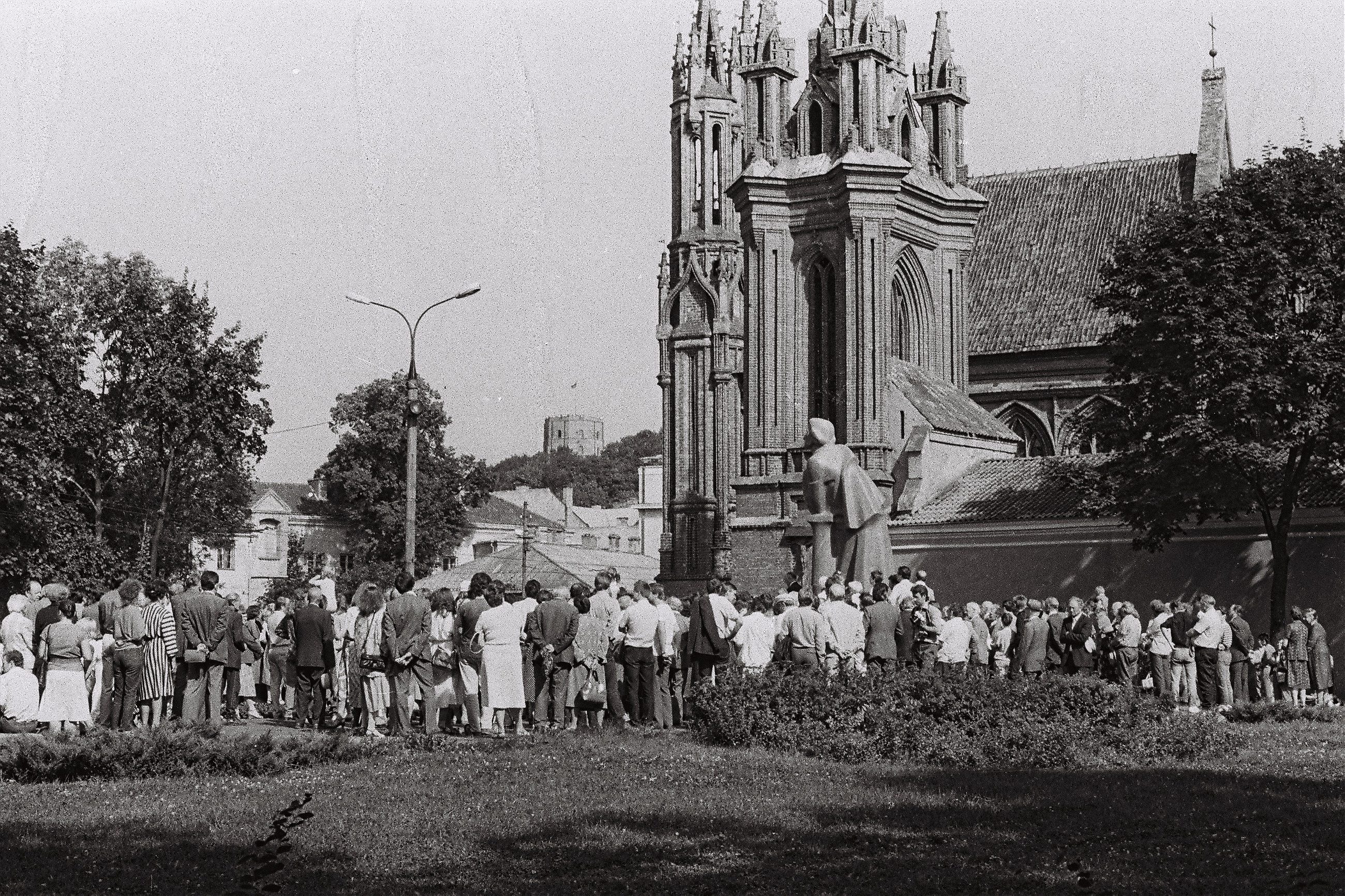
Lithuania is a centuries-old political entity with a tangled history of shifting boundaries, multiple annexations by Poles, Germans, and Russians, and relatively short periods of actual independence. One of those periods came at the end of World War I, when the three Baltic states of Lithuania, Latvia, and Estonia—occupied during the war by Germany and threatened by Soviet takeover afterward—managed to all establish post-war independence. Then, in 1939, Hitler and Stalin signed the Molotov-Ribbentrop non-aggression pact. In it, a secret protocol gave Stalin the green light to absorb the Baltics as a Soviet sphere of influence, and by the end of World War II the Baltics had each been annexed as a republic into the Soviet Union.
In the Soviet version of what followed, Communism brought unprecedented development to industry, agriculture, and education in the Lithuanian republic. In the common view among Lithuanians, Soviet rule mainly brought brutal occupation: mass deportations to remote Siberian locales and prison sentences for anyone who dared express anti-Soviet sentiments.
When Mikhail Gorbachev began freeing political prisoners in 1987, some from the Baltics returned home to resume their agitation against Soviet rule. That summer, dissidents called for public demonstrations in each of the Baltic republics on August 23, the Molotov-Ribbentrop anniversary. Voice of America, alerted by the dissidents, beamed news of the plan back into the Baltics.
Attempts at public protests in the Soviet era had predictable outcomes: arrests, beatings, and at least one massacre by police that ended food riots in the city of Novocherkassk in 1962. Despite Gorbachev’s prisoner release in early 1987, there was not much evidence indicating a new Kremlin tolerance for public displays of anti-Soviet sentiment.
Or at least no evidence that I could see. Some Lithuanians sensed things might be different this time, and their evidence came from an unlikely source: Soviet media.
Like VOA, Soviet media announced there were plans for a demonstration on August 23. Unlike VOA, the Soviet stories condemned the plans as a nefarious CIA plot. I was a newly minted Moscow correspondent, and to me that “CIA plot” allegation sounded like a stern warning: stay away. But to Lithuanians, the fact that Soviet media wrote about a protest before it even happened—well, that was something new. Some of the more seasoned correspondents in Moscow also were intrigued by the coverage and booked travel to Vilnius for August 23. So I did, too.
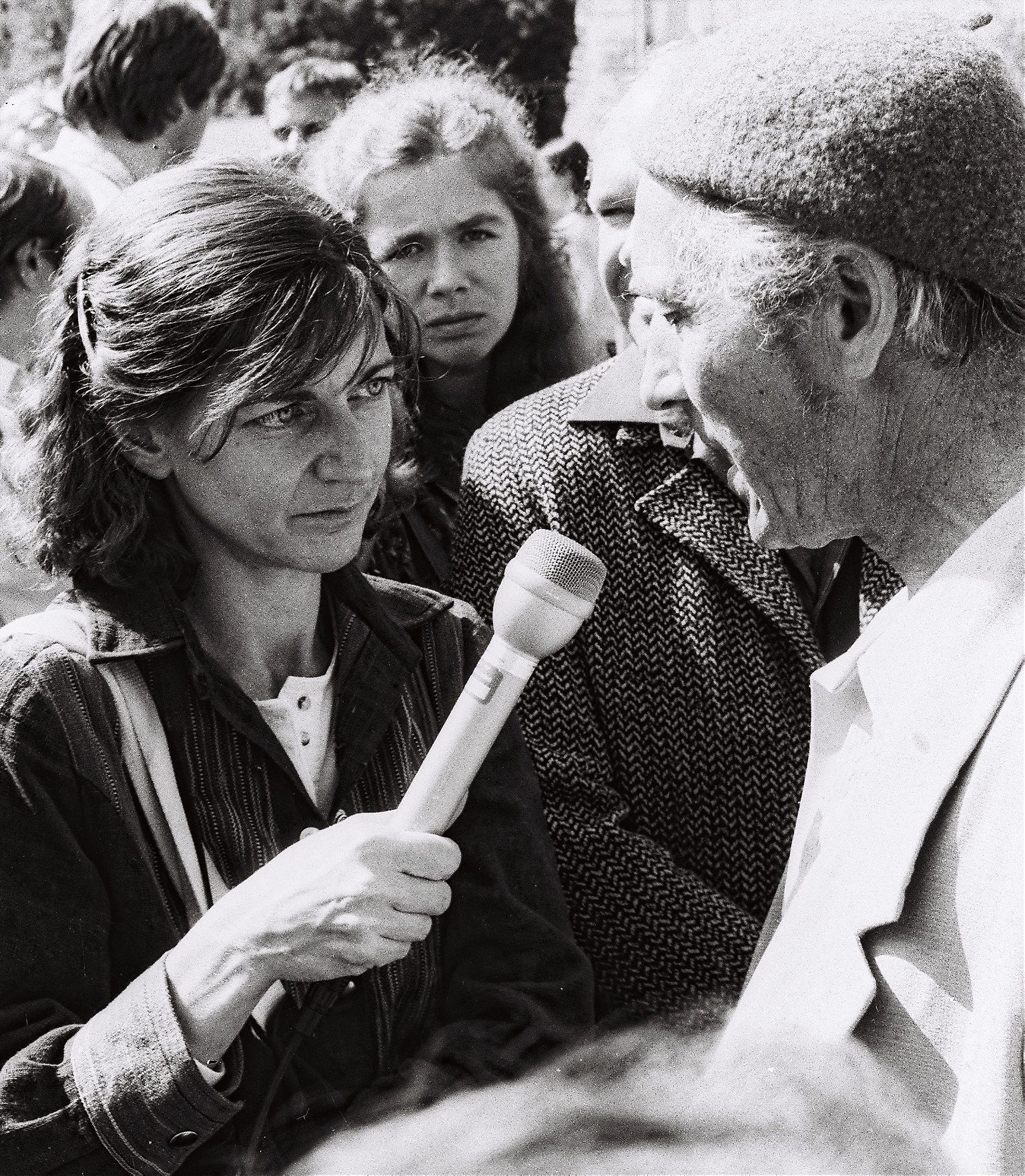
August 23, 1987, was a gorgeous, sunny day. The cluster of foreign correspondents who flew into Vilnius from Moscow that morning headed to the square by St. Anne’s Catholic church, a landmark in an ancient town center whose considerable architectural charms had moldered in the Soviet era. The protest was to take place in the square, next to the church and a statue of the 19th-century Polish poet Adam Mickiewicz, who studied at the university in Vilnius.
People arrived quietly, some clutching flowers, a few escorting their very young children. They stood in small clumps, looking uncertain about how to behave—and about how it all might end.
Then the organizers arrived walking arm in arm, a tiny band that included some of those recently freed by Gorbachev. One of them spoke to the crowd with denunciations of Stalin and calls for Baltic independence. When she finished, everyone sang a Lithuanian hymn. Then another speaker, and another hymn. Speakers condemned the Soviet Union’s jailing of priests and its use of psychiatric prisons to incarcerate dissidents. Police watched from the perimeter while KGB agents in plainclothes ostentatiously circled, photographing and filming. There were chants of “laisvė” and “Lietuva,” Lithuania.
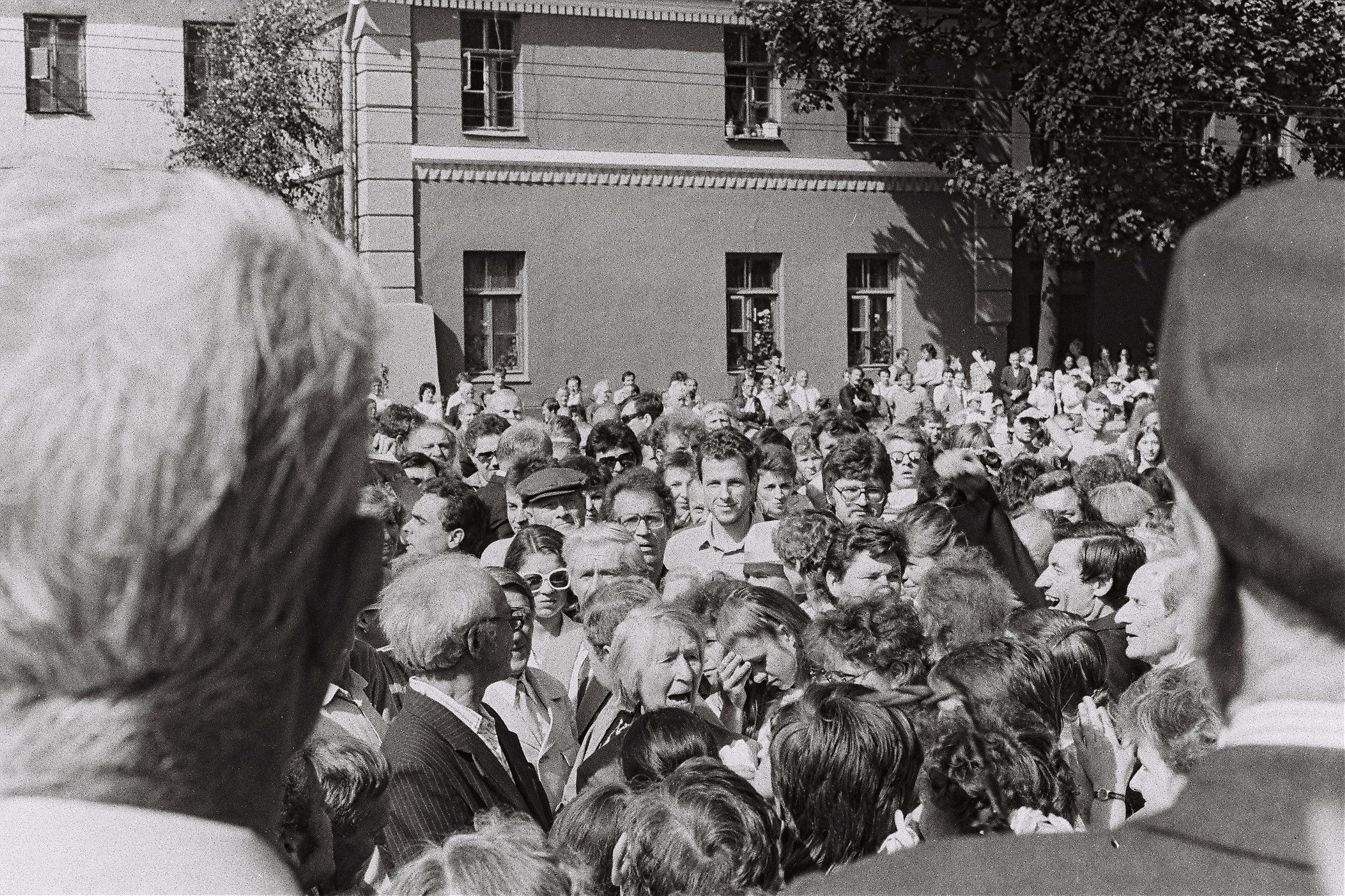
Anyone who watched this century’s mass protests in Cairo or Kiev might see the raw footage, shot that day by Soviet Lithuanian journalists, and wonder: “what was the big deal?” Only a few hundred people showed up and compared with the huge anti-communist crowds of later years in Eastern Europe and the Baltics, the atmosphere was low-key and often tentative.
It was not the crowd’s size that mattered, though, or even the level of its emotion. What mattered was this: the protest continued for two hours, without interruption. More people spoke, more songs were sung. And the authorities only watched. The longer things went without any arrests, the stronger the crowd seemed to grow. Voices were more assured. The singing was less wobbly. It was over when the demonstrators decided it was time to end—not when police rounded them up.
Over the next couple of years, I visited most of the 15 Soviet republics, covering environmental issues, a coal miners’ labor strike, the growing passion among Russians for their long-suppressed Orthodox religion. At the heart of these and so many other stories was a bigger story, the one I’d first witnessed in Vilnius in 1987. I collected string for a “fear” story for months, but I always knew how it would begin: with a long audio scene from that first Vilnius gathering. When my NPR piece on the disappearance of fear aired in the spring of 1990, it was probably the last time I listened to that early Vilnius tape. Until the emails in 2015 from Rimgaudas, telling me: “We got it, the ‘independency’. The dreams fulfilled.” And: “You must come and see.”
Three years passed between that email and the lovely day this April when my husband and I finally arrived in Vilnius on a “come and see” trip. We’d Skyped with Rimgaudas, and arranged to meet him and his wife, Jūratė, a journalist and writer, for dinner in the city’s cobblestoned old town. I remembered the area from Soviet times as dimly lit, dingy and largely deserted at night. In the years since my last visit in 1991, though, when Lithuania was still part of the Soviet Union, independence and European Union aid have transformed its Soviet shabbiness into a beautifully preserved UNESCO World Heritage site, parts of which date back as far as the 15th century.
Our first up-close experience of the change came at our hotel, a 17th-century monastery now fully outfitted for 21st-century tourism—including a receptionist whose cheerful greeting was a welcome contrast with the frosty demeanor encountered by visitors in the Soviet era.
Jūratė and Rimgaudas met us at the hotel and led us off to explore more of old town, whose streets bustled with European tourists, souvenir shops and sidewalk cafes. At Leiciai, a traditional Lithuanian restaurant, we sat in a cozy alcove and ordered cepelinai, a national dish of pork encased in mashed potatoes and formed into zeppelin shapes. It’s unapologetically heavy Eastern European food, which we washed down with one of the several local beers on offer.
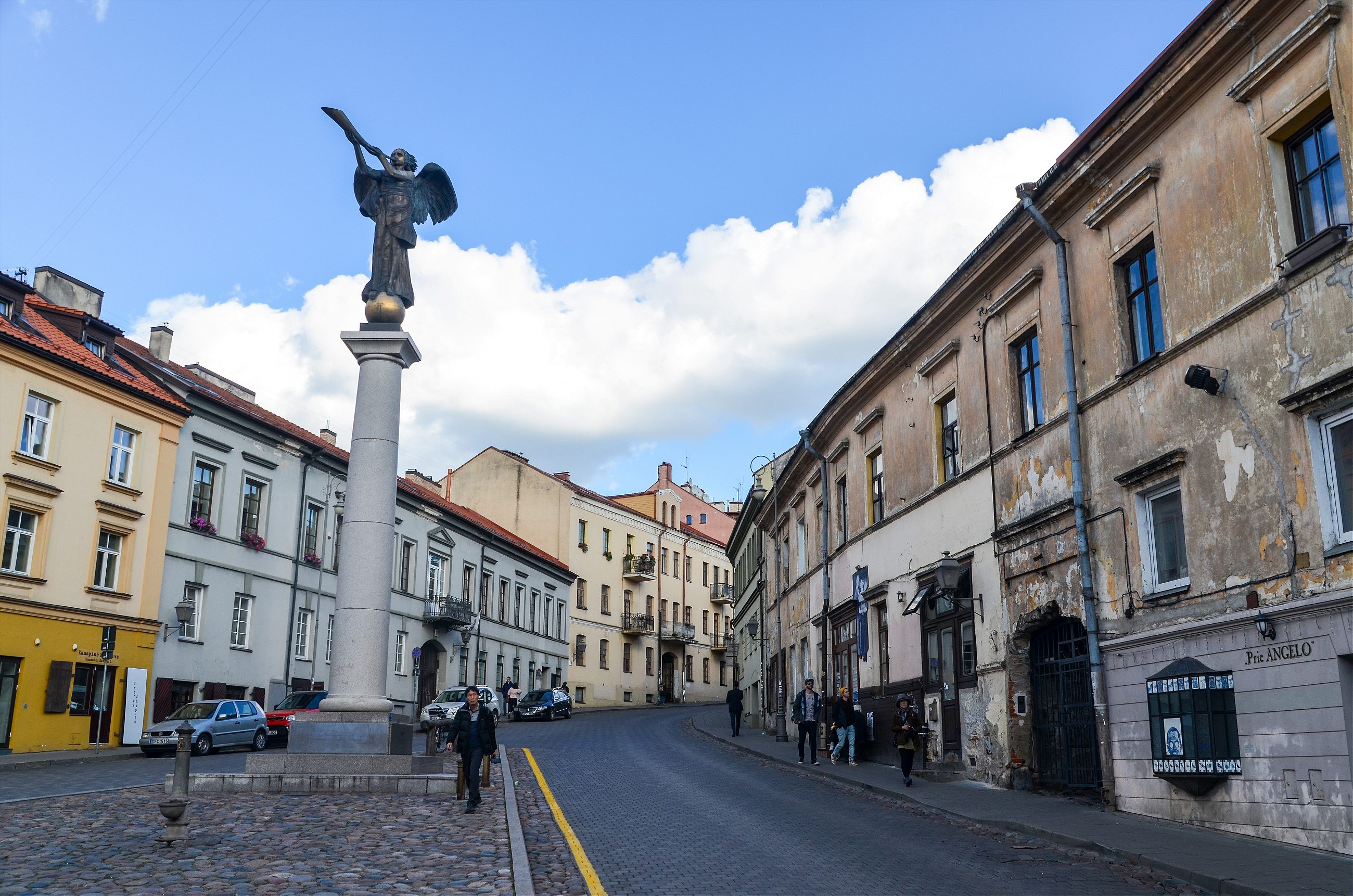
As we ate, Jūratė, Rimgaudas and I parsed memories of 1987 and its aftermath. It was marvelous to relive those moments with people who shared many of my own vivid recollections—and who could tell me what had become of some of the key players of the independence era.
From the distant past, we moved on to our life stories, professional and family. Rimgaudas revealed his parents’ supreme disappointment when he married Jūratė (because she is half-Polish, they considered her “non-Lithuanian”) and then again when he converted to Protestant faith from Catholicism, Lithuania’s dominant religion. My husband and I, both lifelong journalists, wanted to know about media in independent Lithuania. Jūratė’s description of the profession’s financial woes would sound sadly familiar to journalists most anywhere these days. So would her decision to leave journalism, for more lucrative work ghostwriting a biography.
After our dinner, we walked with Jūratė and Rimgaudas under a nearly full moon to the square by St. Anne’s church. A small granite triangle there announces, in English: “Here, 08-23-1987, the first public protest demonstration during the Soviet occupation was held by the Lithuanian Freedom League raising a demand for withdrawal of the occupation army and re-establishment of the independent state of Lithuania.”
I could barely control my emotions as we took photos of the triangle, and of ourselves standing in front of the Adam Mickiewicz statue. Nor could I find words to express what it meant to be back in this spot, with someone I’d spoken with for only a few minutes, after 31 years. As we reflected on what had happened on that square, I felt as bonded to Rimgaudas and Jūratė as I did to almost anyone else I know on the planet.
In the days that followed, my husband and I went to Kaunas to see Daiva, the translator I’d met at the 1987 demonstration. I had visited her in Kaunas once before, in 1991, still in the Soviet era. When she met us at the train station this spring, it felt like we were picking up a conversation we’d just started last week, about our children, our jobs, our travels—and the aftermath of August 23, 1987.
I’d known that police picked up Daiva, her sister and a friend when they got back to Kaunas that evening. They were let go fairly quickly, but while waiting at the police station, they chewed up a bit of evidence they feared might endanger them: my NPR business card. Only this spring did I learn that there were more consequences. Daiva’s friend lost his job for participating in the demonstration, and her sister underwent a painful denunciation session at her workplace. Daiva herself was followed occasionally. Once, she said, a man came up to her in agitation, saying he had valuable information he needed to get to a foreign correspondent. It was clearly a trap. Daiva didn’t take the bait.
As she revealed her long-ago encounter with the agitated stranger, Daiva led us on a marathon walk through a refurbished city center, into beautifully restored churches (done with EU support), and up and down the glitzy floors of a massive new downtown shopping center. We ate lunch at a (very good) Mexican restaurant, a minor post-independence development, to be sure, but one that—like the restored churches and the sprawling shopping mall—was unimaginable in the Soviet era.
In fact, I spent much of the day in Kaunas noting the myriad ways that the city and its life differed from Soviet times. I’d met Daiva’s son back in 1991 when he was a schoolchild. Now he’s married, a father, and—like thousands of other young Lithuanians free to migrate all over the EU—working in England (at least until Brexit becomes official). On her visits to the family, Daiva scours bookshops for her favorite English-language authors, Bill Bryson and David Sedaris among them. It made me smile to think of what a Soviet-era customs agent might have thought if he’d found a Sedaris book in her luggage and taken a read.
But of course, if the Soviet Union had survived with Lithuania still under its rule, Daiva’s son wouldn’t be working in the West. She wouldn’t be allowed to travel there—or anywhere else beyond Soviet borders. And David Sedaris would likely have a permanent spot on a very, very long list of banned literature.
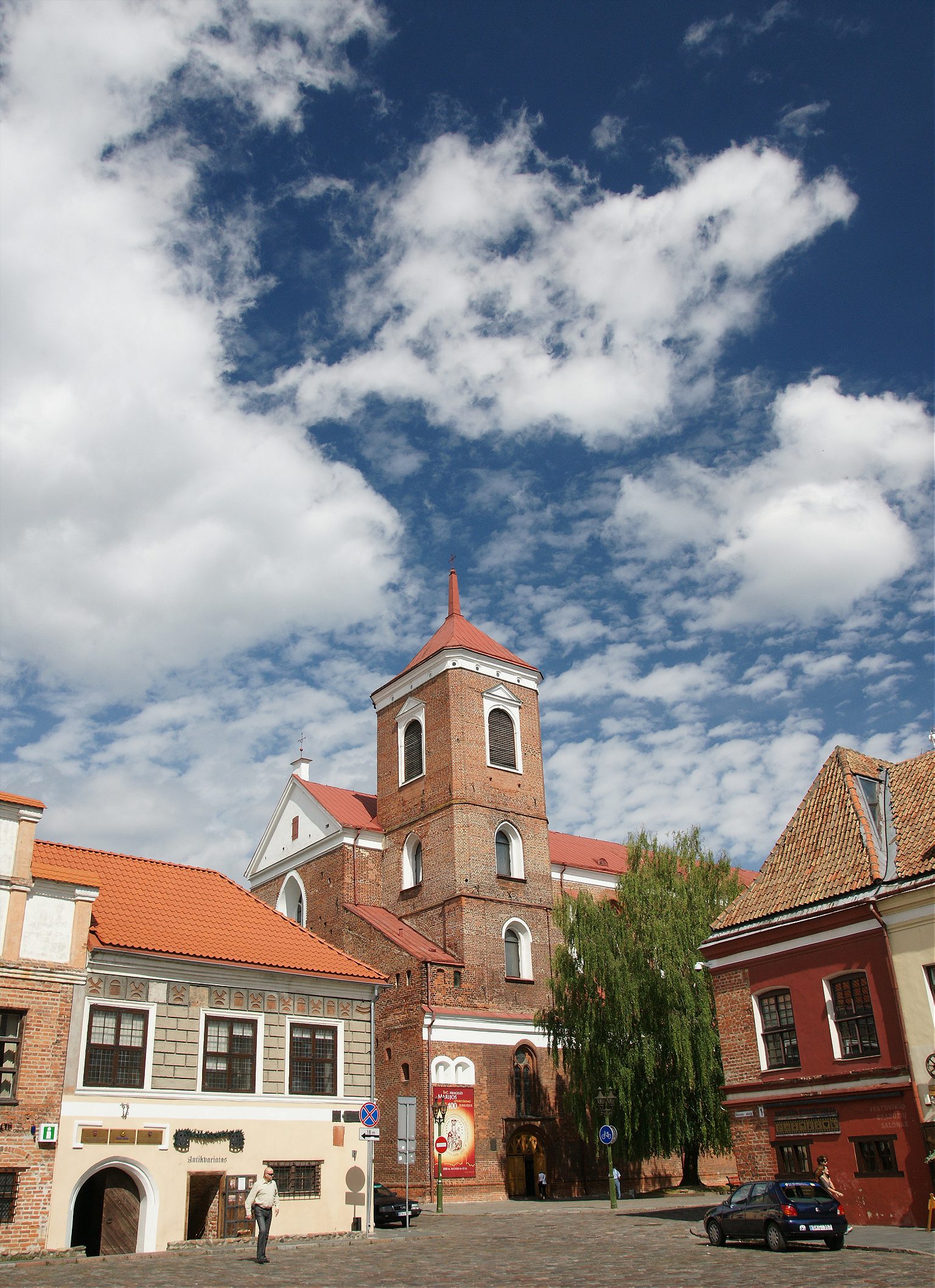
Back in Vilnius, we skipped most of the usual tourist destinations in favor of visiting major landmarks of the independence struggle. I took my husband to sites of the public rallies that grew throughout the late 1980s, as the so-called “singing revolution” in all three Baltic republics drew hundreds of thousands into the streets. The “singing revolution” label captures the atmosphere of peaceful defiance that prevailed throughout those years—and into March 1990, when Lithuanians cheered their Parliament’s unanimous declaration of independence.
In the wake of that defiant vote, the Kremlin cut fuel supplies and imposed economic sanctions on Lithuania. The republic—or at least the 80 percent who were ethnic Lithuanians—remained determined, and peaceful.
Then, in January 1991, the Kremlin took more menacing action. Soviet tanks arrived in Vilnius and swiftly seized control of a few government buildings. Everyone expected the Vilnius TV tower would be one of the next targets because of its vital role as an information source that operated independent from Kremlin control.
In the very early morning of January 13, 1991, thousands had gathered on the hills and lawns surrounding the TV tower, ready to put their lives on the line to block the tanks. I was one of the foreign correspondents at the tower, certainly the scariest night of my life. We witnessed the arrival of the tanks. We watched them roll over cars and passive resisters. We gasped at the percussive explosions and the rat-a-tat of gunfire. When the military assault ended, it had claimed 14 civilian lives and restored Lithuanian broadcasting to Kremlin control.
The story of the assault would reverberate around the world—if we could get it out of Lithuania before the Kremlin cut phone lines or rounded up all the foreign correspondents.
I went from the TV tower to Parliament, one of the few places in Vilnius with phones that could reach outside the Soviet Union. When I finally found an international line, I realized it would be futile to call NPR headquarters in Washington, D.C. It was Saturday night there, Weekend All Things Considered was off the air, and the building would be deserted until the Sunday morning staff arrived. I rang my editor, John Dinges, at home. Somehow, he found an engineer who raced into NPR so that I could feed all my audio into the network’s recording room.
Then I left Parliament, knowing it could well be the next target for assault. I took up refuge in an apartment building across the way, where NPR’s Sunday morning host Liane Hansen reached me a few hours later. In our interview, I poured out the story in a stream of consciousness monologue, interrupting myself occasionally to hold the apartment phone up to an open window. Can you hear them, I asked Hansen—“them” being the crowds that were now assembled outside Parliament, chanting “laisvė” and “Lietuva,” as they had earlier that day at the TV tower.
It’s very loud, very determined, I said.
“Yes, we can hear it very well here,” Hansen assured me. Then she asked how I felt about what I’d witnessed.
What I’d seen was a moral outrage, like the Soviet crackdowns of earlier eras in Hungary and Czechoslovakia. But that Sunday, I hadn’t even begun to process it or to think of how to put it in some larger context. “I’ve been to Lithuania many times. I’ve lived in this country [the Soviet Union] for four years,” I told Hansen. “And frankly, I still find it hard to, to accept the idea that such brutal force could have been used against unarmed people here.”
In seeking “the truth” as reporters, we often find that our goal resides in some gray area. Not so with the Baltics’ David-and-Goliath rebellion against Soviet power, and certainly not so on January 13, 1991, when the difference between the “good guys” and the “bad guys” was visible with heartbreaking clarity.
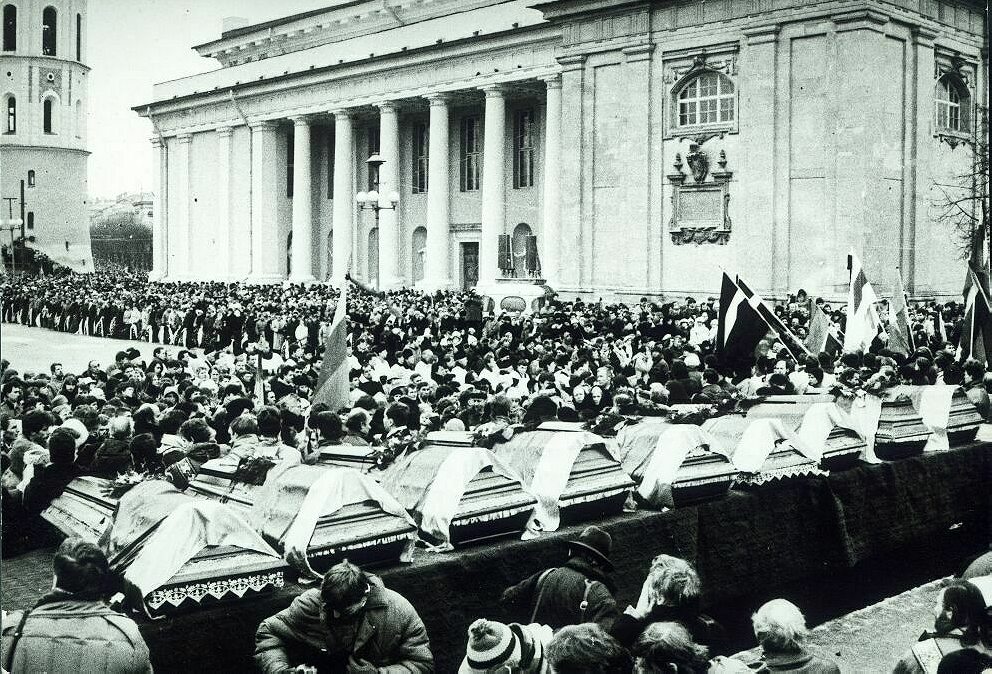
When it happened, the assault on the TV tower felt like the end of Mikhail Gorbachev’s reformist efforts. In retrospect, it was a different kind of turning point. Gorbachev later claimed the military acted without his permission, even suggesting they had organized the attack as “a provocation” to discredit him, according to William Taubman’s authoritative biography ‘Gorbachev: His Life and Times”. Others close to the Soviet leader disputed his version. In all the years since, no one has ever really clarified why the phone lines were never cut, or why the military didn’t attack the parliament building and the civilian crowds who massed outside to protect it.
Whatever the reasons, the assault ended there. Some months later, after an equally dramatic scare—the August 1991 coup attempt that failed in Moscow—the Soviet Union just unraveled. By the end of 1991, Gorbachev resigned. The union was dissolved. Lithuania and the 14 other Soviet republics were now standalone states.
In seeking “the truth” as reporters, we often find that our goal resides in some gray area. Not so with the Baltics’ David-and-Goliath rebellion against Soviet power.
By the time actual independence arrived, I had moved from Moscow to get ready for another assignment. In the years that followed, any headline with “Lithuania” or “Baltics” would catch my eye, but that happened pretty rarely. Stories on tensions between Moscow and the Baltics—always fearful of new aggression from their huge eastern neighbor—are a staple in Western media. So are reports on discrimination against the Russian minorities still living in the Baltics. Beyond that, learning more detail about post-independent Lithuania’s lurch into capitalism and democratic politics requires a fair amount of online fishing.
That’s not surprising. It’s a small country, even smaller since EU membership enabled hundreds of thousands of Lithuanians to move away, to live and work in other European states. And Lithuania no longer has the outsized geopolitical importance it had when I went there to cover demands for “laisvė” from the Soviet Union.
For many who lived through the independence transition, though, it was a very bumpy ride. On the economic side, the well-known chaos of Russia in the 1990s had echoes in Lithuania, where bank collapses and monetary devaluation hit the elderly particularly hard. And the near-unanimity of Lithuania’s pro-independence politics of the late Soviet era turned rough and tumble after 1991. Former allies split, new parties formed and corruption scandals sank more than one political leader.
Things looked up when Lithuania joined the EU and NATO in 2004, then down again with 2008’s global bust, prompting an essay in Foreign Policy that described Lithuania, Latvia, and Estonia as “prime candidates to be the new basket cases of Europe, with their double-digit economic declines, beleaguered governments and shriveling state spending.” It sounded like a death knell for a region that had seemed so full of democratic promise and optimism.
A few years later, though, the Baltic economies were recovering. Lithuania’s rebound was led by Dalia Grybauskaitė, elected president in 2009, now in her second term, and often dubbed Iron Lady by both supporters and detractors.
With recovery has come some revised analysis. In an interview last year, for example, Edward Lucas, author of the bleak Foreign Policy assessment, said he now sees “many positive signs.” While Lithuania, Latvia, and Estonia remain small, relatively obscure and geopolitically vulnerable, “I think the Baltic states have a very bright future,” he said. “I’m very optimistic about them.”
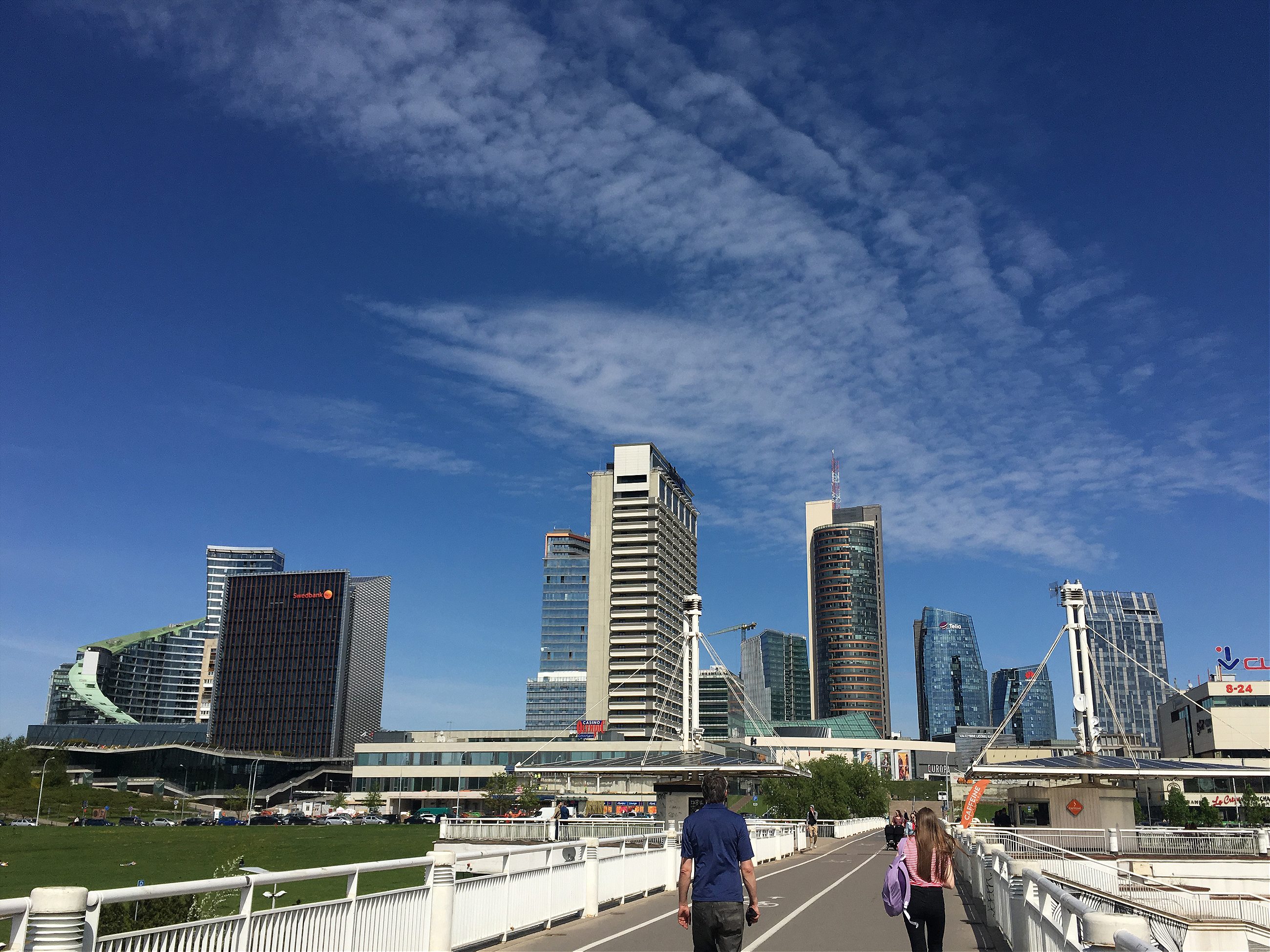
In one of our early email exchanges, Rimgaudas gave me a terse resume of his post-independence life:
“15 years in tourism-hotels business, got rich before the crisis, lost everything during the crisis,
1 year unemployed…
4 years in Istanbul logistics company
There got a hobby movie script writing”
It was, to say the least, far from the career path he might have expected in the Soviet Republic of Lithuania. When I asked how he got from his physics Ph.D., awarded in 1993, to a job in tourism, he said, “Democracy makes more possibilities.” And the first possibilities many people sought to explore were financial.
The first tourism company he worked for paid him triple what he might have made in academia. It didn’t matter that “I’d never learned anything about tourism,” because few people in Lithuania had any experience in western-style travel. The relatively few foreigners hardy enough to visit in the Soviet era were completely at the mercy of Intourist, a state agency whose employees prioritized tourist control, not tourist comfort.
After a decade or so at various tourism ventures, Rimgaudas and Jūratė made a personal investment in a new hotel outside Vilnius. The capital came from the sale of Jūratė’s family home in central Vilnius. Real estate was booming—until everything crashed, sending their new investment crashing with it. Rimgaudas spent 2009 bankrupt and unemployed. A training course designed to help steer him in new directions prompted him to write several movie screenplays, though none of them sold. Eventually, he went to work for a logistics company—in Istanbul, where he lived four years before returning home to work in the same field.
I was amazed at the matter-of-fact way Rimgaudas recounted his boom-and-bust work life. Maybe I shouldn’t have been, though. One day he sent me a link to a video application he’d made to Mars One, a private Dutch company that vowed to build the first human settlement on Mars. “I would like to go to Mars because of curiosity,” he said in the video, though he acknowledged that Jūratė was against it. Clearly, Rimgaudas was someone not afraid to dive into the unknown—just as he’d been willing to take a risk back on August 23, 1987, at that first protest.
How had he assessed that risk? We knew the protest might end with arrest or beating, he told me, but the likelihood of either outcome seemed much lower than in the past—“only about 20 percent.” Low enough, apparently, that it didn’t feel too dangerous to take daughter Kotryna, then 18 months old. Kotryna is now a fine arts photographer in Glasgow. One of her projects is called “Independency.” It incorporates that 1987 audio I pulled out of storage, where her father struggled (as did others I interviewed that day) to define exactly what Lithuanians were seeking.
Seen through my then-versus-now prism, the once dingy, oppressive Soviet city now sparkled with something new.
When I returned to the Vilnius TV tower this spring, I spent a long time in its tiny gallery of photos of the Soviet military attack. The images that punched my gut hardest were not from the night of the tank assault, but from a few days later when a massive crowd—all of Lithuania, it felt like—lined the central artery of Gediminas Street to pay homage to the victims. It was a frigid, sorrowful day, but a completely peaceful one, even when word spread about the Big Lie story broadcast by Alexander Nevzorov, a popular St. Petersburg TV anchor. Against a flaming background and, in one image, with an automatic rifle slung over his shoulder, the anchor turned truth on its head. The Soviet special forces and their tanks had saved Lithuania, he said. And those dead civilians shot or run over by tanks? They were all phony, he claimed—every one of them a victim of a heart attack or a car crash.
After the photo gallery, my husband and I got in an elevator that whisked us up the equivalent of 55 floors to the top of the TV tower. It’s now home to a revolving restaurant where we ordered lunch and looked down on a 360-degree panorama of post-independence Vilnius. We’d already walked most of the old city’s streets and explored sleek new offices near Parliament, where startups can rent co-working space and Delfi, the most popular independent news site, has its modern, multimedia newsroom. We’d visited the museum in the old KGB headquarters that is a center of controversy over its use of the term “genocide” to refer to the Soviet occupation (the name has since been changed but the controversy rolls on). And we tracked down the old Intourist hotel, now a Radisson Blu undergoing expansion.
From our lofty platform at the top of the TV tower, we could see how spring had turned the city’s open spaces a voluptuous green. High rise banks and other enterprises confirmed the long-ago demise of the Soviet planned economy.
It wouldn’t have been an earthshaking scene for most visitors, I imagine. But seen through my then-versus-now prism, the once dingy, oppressive Soviet city now sparkled with something new. It took a while for me to name it. The new thing was just this: normality. Vilnius, the capital of independent Lithuania, now looked like a normal European city.
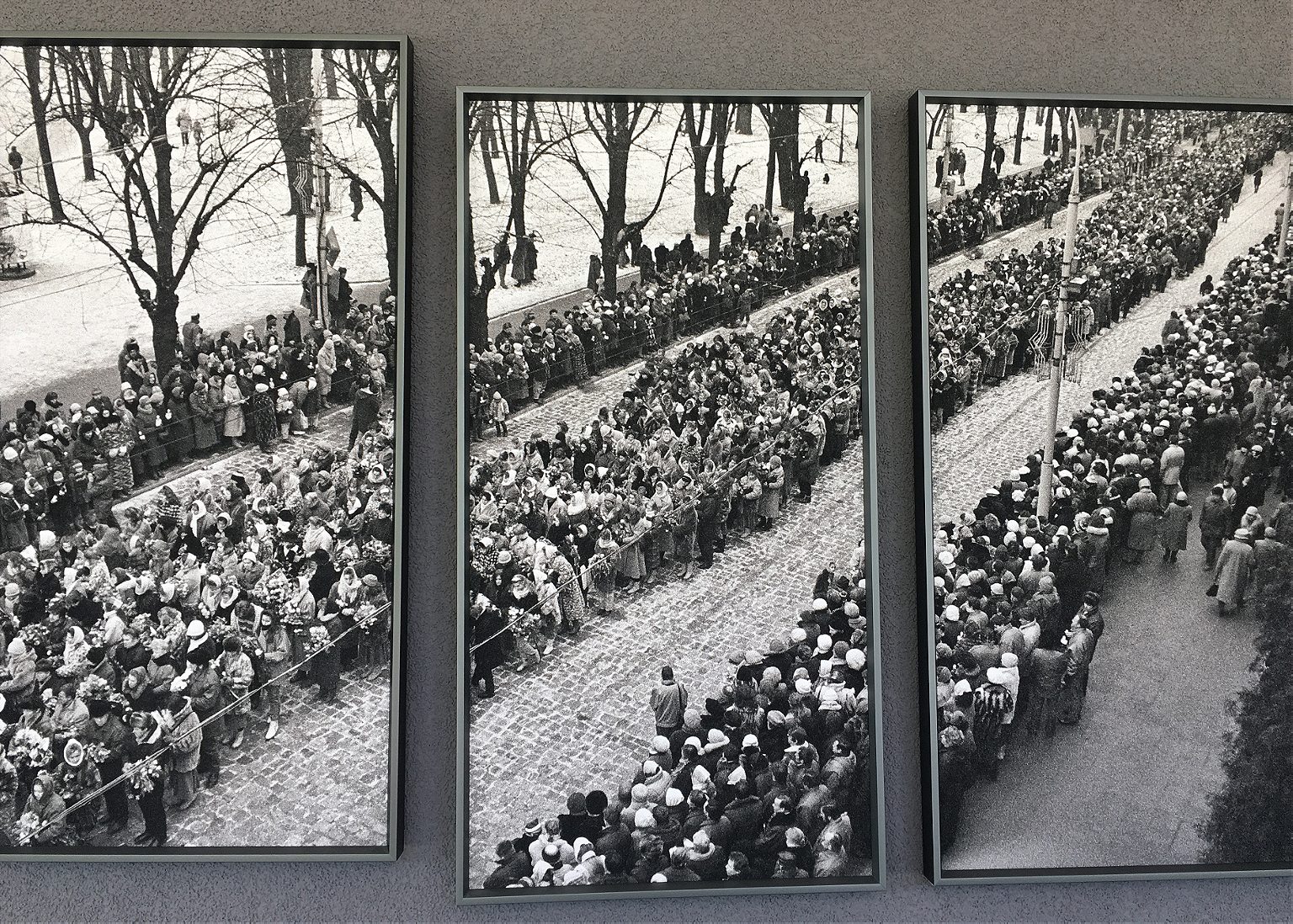
I Skyped last month with Kotryna, the daughter Rimgaudas and Jūratė brought to the 1987 demonstration in her baby pram. She lives permanently in Glasgow now, but when I reached her she had just returned from curating an international photography symposium in Lithuania.
Kotryna said that when she visits Lithuania, much about her homeland strikes her as “like any other European country.” But her visits, like my very brief stay in the spring, usually focus on Vilnius, and on its restored and busy political and commercial center. “There is massive inequality between Vilnius and villages, and even (central) Vilnius and the outskirts,” she said.
Official measurements confirm the wealth gap. Lithuania is one of 38 countries—most of them European—in the Organization for Economic Co-operation and Development (OECD), which measures the economic and social well-being of its member states. Among the 38, Lithuania ranks 31st in income inequality. It’s also well below most OECD states on poverty measurements (though it ranks higher than the U.S. in all of these categories).
On other international yardsticks, Lithuania—like its Baltic neighbors Latvia and Estonia—gets good, to very good, marks. It’s 36th out of the 180 countries in the World Press Freedom Index of Reporters Without Borders (nine places ahead of the U.S.), and it ranks 38th out of 180 on Transparency International’s corruption index (where the U.S. is 16th). The comprehensive “democracy” ratings of Freedom House have consistently rated Lithuania and the other Baltics “free” based on its measurements of conditions such as political rights, civil liberties and rule of law. The Baltics are the only former Soviet republics rated “free;” among the rest, six are “partly free” and six more, including Russia, are “not free.”
“The Baltics are seen as a kind of island of stability in the region” even though their images are “not so shiny” on some rights issues, said Liutauras Gudzinskas, a Vilnius University professor who is writing the 2018 Freedom House report on the region. Last year, for example, Freedom House dropped Lithuania’s civil society rating a bit after Parliament passed a law defining the foundation of a family as a union between a man and a woman. And the government continues its stubborn refusal to deal with evidence that some of Lithuania’s partisan heroes—men revered for fighting in forests against Soviet power after World War II—likely also were responsible for killing Jews during the war period.
While it stonewalls on the partisans controversy, the government seems to grab every opportunity—even trivial ones—to rail about the Soviet occupation of Lithuania. Just last month, the Lithuanian ambassador to the U.S. demanded that Walmart stop selling t-shirts adorned with the Soviet hammer and sickle because they are “symbols of mass murder.”
In our Skype call, I asked Kotryna if she remembered anything from the earliest days of independence. She was still a child, with a child’s memories of never-before-seen fancy chocolates, bubble gum, a Barbie doll. “Bananas arrived also. Suddenly, there were banana stands everywhere,” she said. Her younger sister, who had never eaten one before, bit into the whole fruit, skin and all.
When I’d asked Rimgaudas about those early days, his response was very different. Actual independence, by most definitions, only came in 1991 with the collapse of the Soviet Union. That’s when the chocolates and bananas arrived. But for Rimgaudas, the turning point was almost two years earlier, in March 1990, when Lithuania’s Parliament passed its declaration of independence. From that moment, he said, “we were already free.”
This August, on the anniversary of the Molotov-Ribbentrop pact signing, I opened my email to find another message from Rimgaudas.
By now I was used to his terse communiques, and this one was no exception. Still, it packed joy into its handful of words.
The subject line: August 23 again!
Inside was this:
“Greetings.
It is not a sad date anymore…”
